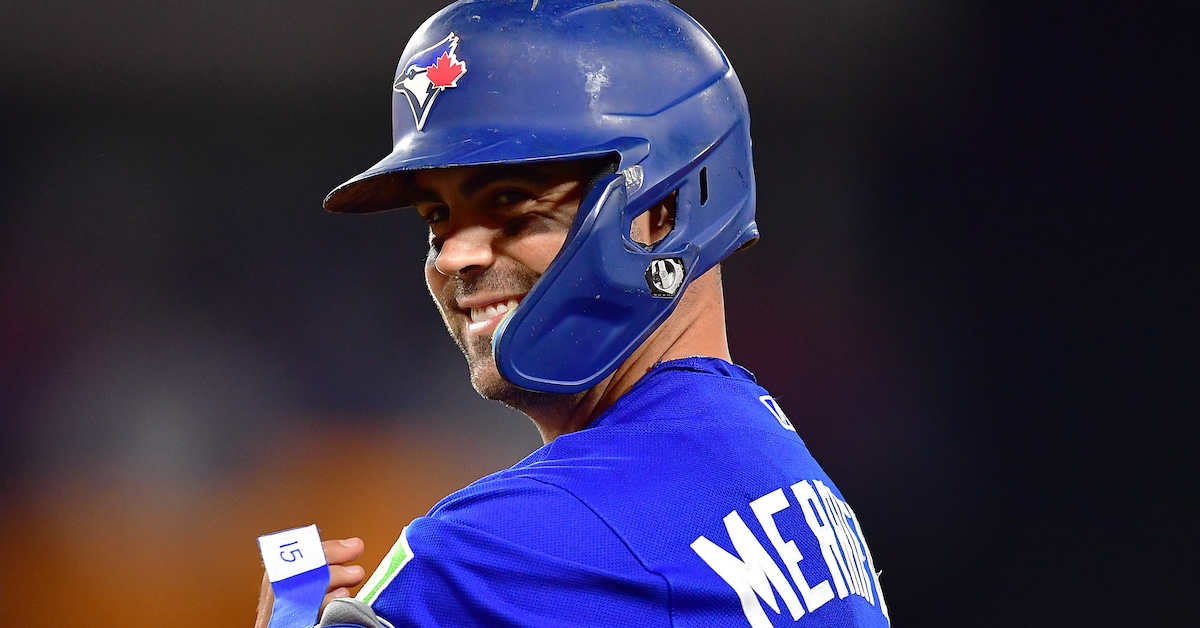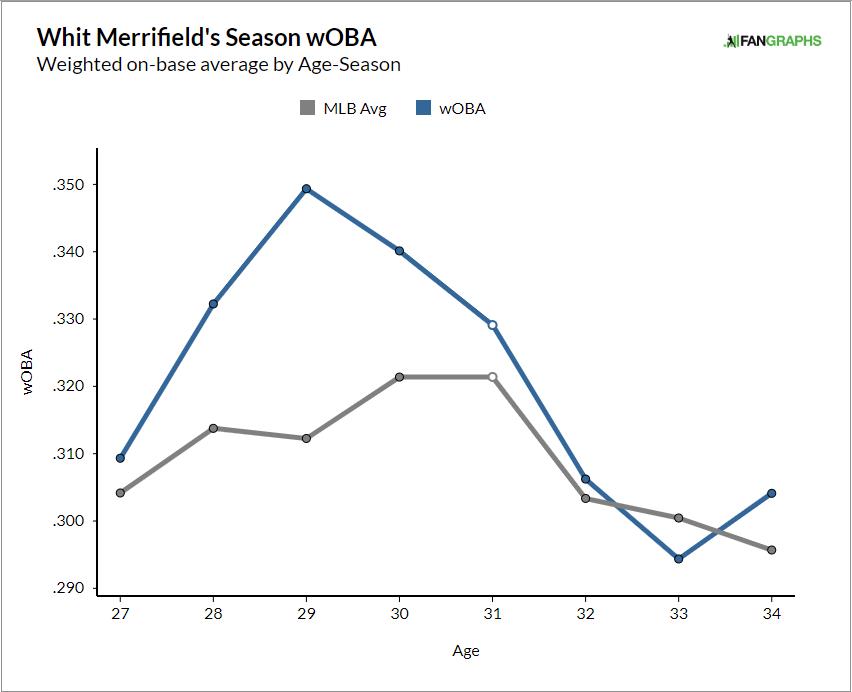
Gary A. Vasquez-USA TODAY Sports
The Phillies have the most stable roster in the major leagues. Not the best, the most stable. All five rotation spots are spoken for, the bullpen is pretty well settled, and at least eight of their nine starting lineup spots have strong incumbents, all of them under team control through at least 2025. Four of them are under team control through 2027.
This is a team that loves to throw around big money in free agency, but after re-signing Aaron Nola in November, and with an extension for Zack Wheeler looking likely, there isn’t really anyone obvious for the Phillies to spend that money on. So, after shoring up some Quad-A rotation depth with split contracts for Kolby Allard and Spencer Turnbull, the Dave Dombrowski-Sam Fuld duumvirate has turned its quartet of eyes to Whit Merrifield. The former Royals and Blue Jays speedster will make $8 million guaranteed, with an $8 million club option for 2025.
Sorry, this is first reference, and I forgot to use his full name: Whitley David Merrifield, Whose 11th-Inning Walk-off Single Led South Carolina to Its First College World Series Title in 2010. It’s a mouthful. (At the risk of overdoing the Gamecock baseball trivia up top, Merrifield just missed overlapping with Bryce Harper’s older brother Bryan, who pitched for Carolina the year after Merrifield got drafted.)
Signing Merrifield is an attempt to address the Phillies’ bench depth, which was a major weakness in 2023. It wasn’t the principal reason the Phillies blew a 2-0 lead in the NLCS, but it’d make Rob Thomson’s job a lot easier if he had better situational and pinch-hitting buttons to push than “Let’s see if Jake Cave ate his spinach this morning.”
The Phillies would probably like to upgrade at one or two positions, but any move would require them to get rid of an incumbent starter — most likely a Nick Castellanos or Taijuan Walker, both of whom have three years left on their contracts. The Phillies also don’t have a great farm system, which further limits opportunities for trade. So a bench upgrade it is.
Merrifield’s $8 million guarantee — $7 million in salary, plus a $1 million buyout of next year’s option — takes the Phillies’ Competitive Balance Tax number to $261.1 million for 2024. That puts them into the surcharge bracket, penalizing teams that spend between $20 million and $40 million over the tax threshold, but they still have almost $16 million in wiggle room before they start incurring draft pick penalties.
It’s worth keeping an eye on that situation, but a potential tax bill crunch is also a problem that can be dealt with closer to the trade deadline.
So what does $8 million worth of Merrifield get you these days?
I’ll lay out the optimistic spin on the situation first, if only to establish precisely what I intend to pour cold water on a couple hundred words from now. Merrifield is a three-time All-Star with major league experience at every position except for shortstop and catcher. He led the American League in stolen bases three times and hits twice, and he has two seasons of a .300 batting average and a .340 or better OBP.
Merrifield played most of his games last year at second base and left field, which are the two positions at which the Phillies have a left-handed-hitting starter who’s a candidate to get rest against unfavorable platoon matchups.
And while $8 million is a lot to pay for a bench bat, wow, all that stuff sure seems like a steal to me!
Now for the cold water. For starters, while Merrifield can theoretically play all over the diamond, his home positions are those at which the Phillies are strongest defensively. Bryson Stott and Johan Rojas are both elite defenders at their respective positions. Brandon Marsh is a capable defensive center fielder; left field is a breeze for him. And if the Phillies have further need of defensive help, they already have Edmundo Sosa to cover the infield and Cristian Pache as a fourth outfielder. Both are right-handed hitters, like Merrifield.
And while Merrifield was the Rickey Henderson of the 2010s, he isn’t a great percentage basestealer. He was 26-for-36 last season. Stott was 31-for-34, while Rojas was 14-for-15 in just 59 games. The Phillies aren’t a perfect baserunning team — Kyle Schwarber couldn’t outrun congressional procedure, and Harper runs the bases the way a desperate man plays poker — but they do have a ton of high-percentage basestealers: Stott, Rojas, J.T. Realmuto, and Trea Turner foremost among them.
Maybe some of that will rub off on Merrifield, but that’s another facet of the game in which I don’t see him improving the Phillies much. Obviously there will be pinch running opportunities for Schwarber or Castellanos, but again, Pache could’ve done that just as well.
The spot Merrifield is best suited to fill is as a situational starter in the outfield, in one of two roles: First, against lefties when the Phillies don’t want to use Marsh. The current procedure against tough lefties is for the Phillies to start Rojas in center and Pache in left, which leaves the lineup woefully short. If Merrifield is an offensive upgrade on either of those two — and it wouldn’t take much — that’d be quite useful.
And then there’s situation no. 2: as a replacement for Rojas and/or Pache when the matchup or game state requires offense and not defense. I’d be inclined to let Rojas roll as the everyday center fielder, because I love every single thing about his game except for the fact that he never walks, doesn’t hit the ball hard, and hits it on the ground. These flaws are few, but they are, unfortunately, vitally important. As for Pache, I don’t know why the Phillies are still carrying him, because of how totally his skill set overlaps with Rojas’.
Merrifield is another fast right-handed-hitting outfielder, but he has an extended track record of hitting well in the major leagues, which Rojas and Pache do not.
But about that track record. A lot of the hype about Merrifield — his positional flexibility, his inexhaustible collection of singles and doubles — is based on a conception of the player that’s about three or four years old now:

I’m ordinarily pretty forgiving when it comes to a player putting up one bad season, or having outperformed poor underlying numbers, but we’re entering season three or four of a pretty clear decline for Merrifield now. Not only that, but the decline started in his age-30 season and continued throughout his early 30s in precisely the manner you’d expect a player to age:
The Gradual Decline of Whit Merrifield
| Season |
BB% |
K% |
AVG |
OBP |
SLG |
BABIP |
HardHit% |
wOBA |
xwOBA |
| 2016 |
5.7% |
21.7% |
.283 |
.323 |
.392 |
.361 |
34.4% |
.309 |
.292 |
| 2017 |
4.6% |
14.0% |
.288 |
.324 |
.460 |
.308 |
29.4% |
.332 |
.327 |
| 2018 |
8.6% |
16.1% |
.304 |
.367 |
.438 |
.352 |
31.0% |
.349 |
.343 |
| 2019 |
6.1% |
17.1% |
.302 |
.348 |
.463 |
.350 |
28.8% |
.340 |
.324 |
| 2020 |
4.5% |
12.5% |
.282 |
.325 |
.440 |
.295 |
27.3% |
.329 |
.336 |
| 2021 |
5.6% |
14.3% |
.277 |
.317 |
.395 |
.309 |
28.6% |
.306 |
.301 |
| 2022 |
6.9% |
15.5% |
.250 |
.298 |
.375 |
.276 |
30.9% |
.294 |
.288 |
| 2023 |
6.1% |
17.1% |
.272 |
.318 |
.382 |
.313 |
24.1% |
.304 |
.274 |
So yeah, it’s been about three years since Merrifield actually played like an All-Star over a full season, and nothing is trending in a direction that makes you think he’s headed back there.
One more table before I wrap things up. There are players you’d expect projections systems to have a hard time with — actually, Rojas is a great example — but Merrifield isn’t one of them. He has eight seasons of major league track record, a style of play that is both common and consistent, and an aging curve that’s bent according to historical norms. ZiPS ought to have a good handle on Merrifield, and the outlook is pretty bleak:
Whit Merrifield’s 2024 ZiPS Projection
| Age |
G |
PA |
HR |
R |
RBI |
SB |
BB% |
K% |
ISO |
AVG |
OBP |
SLG |
wOBA |
wRC+ |
WAR |
| 35 |
117 |
488 |
8 |
56 |
54 |
16 |
6.1% |
17.0% |
.109 |
.249 |
.295 |
.358 |
.284 |
79 |
0.6 |
I’ll end with two caveats. The first is that as much as this just looks like Merrifield’s bat is slowing down, the Phillies have a good major league hitting coach, Kevin Long, so there’s a non-zero possibility that he can adapt something about Merrifield’s game to get him back up to being a league-average hitter. Nothing obvious jumps out to me, but it happens.
The other caveat is that he isn’t going to get anything like 488 plate appearances. If the league thought Merrifield could play every day, he would’ve gotten a multi-year contract worth eight figures a season. The Phillies’ one-year-plus-option deal reflects the likelihood that Merrifield is just going to spend a lot of time on the bench.
Merrifield’s game doesn’t really lend itself to popping in a reduced role; he has pretty even platoon splits for his career. But even if he’s bad, there’s going to be a limit to how much damage he can do, considering the Phillies’ aforementioned lineup stability. And if he ends up going south of an 80 wRC+, the Phillies under Dombrowski have had no qualms jettisoning an underperforming veteran on an expensive one-year deal.
Until then, this is at least an attempt to address a serious area of need. It’s not as exciting as signing Blake Snell or Cody Bellinger, but what is?
Source
https://blogs.fangraphs.com/phillies-take-the-walt-whit-man-bridge/
 Backyard GrillingWeekend WarriorsAdvice from DadBeard GroomingTV Shows for Guys4x4 Off-Road CarsMens FashionSports NewsAncient Archeology World NewsPrivacy PolicyTerms And Conditions
Backyard GrillingWeekend WarriorsAdvice from DadBeard GroomingTV Shows for Guys4x4 Off-Road CarsMens FashionSports NewsAncient Archeology World NewsPrivacy PolicyTerms And Conditions
